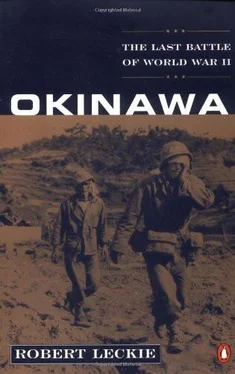Halsey’s losses, meanwhile, were minimal: five pilots and four crewmen carried as missing in action and twenty-one planes lost. Upon the approach of night, Halsey reversed course, speeding southward again to strike Formosa, confident that before Okinawa’s cratered airfields could be repaired and replacement planes flown in, TF 38 could complete its mission without intervention from the Great Loo Choo.
Kamikaze Strike / Franklin’s Ordeal
CHAPTER SIX
In the middle of March the planning stages for Operation Iceberg came to an end and the preinvasion bombardment intended to soften up Okinawa for the attack began. Now Task Force Fifty-eight under Admiral Spruance sortied from its anchorage at Ulithi for the first phase of destroying enemy airpower based on Kyushu.
Spruance’s fast carriers could not have appeared at a more difficult time for Admiral Ugaki. Preparations for Ten-Go were not complete, and even if they had been, the Heavenly Operation’s prime targets were to be comparatively defenseless troop transports and supply ships—not those seventeen dreadful American flattops with their thousand airplanes, those half-dozen big battleships, those fourteen cruisers—all of which could fight back. Only the Fifth Air Japanese Fleet was ready for action, and of its eight air groups two were strictly one-way suiciders. Even these heroic kamikaze had been so few hours in the air that they still had difficulty landing their planes. Kyushu’s fifty-five airfields had not yet been made ready for the anticipated raids, although Ugaki’s engineers were tunneling into the hills to shelter pilots, troops, ordnance, and repair facilities, while camouflaging runways and littering abandoned fields with dummies and useless aircraft. Communications were poor—as they usually were among the Japanese—and there were real problems in transmitting orders from Ugaki’s headquarters at Kanoya. Poor mechanical communication inhibited Japanese battle coordination throughout the war, but even worse was the consistent failure to report defeat, perhaps because to do so would require the unfortunate commander to kill himself. Probably the worst instance of this peculiarly Japanese weakness was after the Battle of Midway. Admiral Yamamoto never told the Army he had lost four carriers there; although he informed Premier Hideki Tojo he had been defeated, he never supplied the details. Emperor Hirohito heard nothing. On a much smaller scale, but perhaps even more shocking, was the report to Tokyo Headquarters of the complete annihilation of the two-thousand-man Ichiki Detachment by the Second Battalion, First Marines, on Guadalcanal. All that was revealed was that “the attack of the Ichiki Detachment was not entirely successful.” Japan’s unique ideographic language was another cause of imprecise orders. Finally, the acrimonious debates that could divide staff planners at every level was one more hindrance; such a furor arose at Imperial Headquarters over whether or not to use the Special Attack Forces against Spruance’s approaching fleet.
One side was against expending the kamikaze against enemy warships when the true purpose of Ten-Go was to destroy as many troop transports and supply ships as possible, while the opposing group argued that a passive defense on Kyushu would expose the island to such destruction from sea and sky that there wouldn’t be any aircraft left to strike TF 58. In the end, Tokyo ordered Ugaki to hit Spruance with what he had.
He did. From the start of the American attack at 5:45 A.M. on March 18 and throughout the following day Ugaki hurled 193 planes—including 69 kamikaze —at the Americans again attacking in four separate carrier groups. Of these, 161 planes—or 83 percent—were lost, while another 50 planes were damaged on the ground. Even with such staggering losses Admiral Ugaki was gratified, for his pilots—again retrieving victory from defeat with a few strokes of the pen, and for whom all minnows were whales during those two days—had reported hitting five carriers, two battleships, three cruisers, and one unidentified ship. But they reported these “losses” with such joyful shouts of victory that Ugaki assumed that they were all sunk, and that Spruance had withdrawn because his fleet was so badly crippled that the Okinawa invasion would be postponed for some time.
Actually, TF 58—though shaken—was far from being crippled. Japanese bombers had indeed scored hits, damaging four big carriers: Wasp seriously and Franklin so badly that she was presumed lost. It was at exactly 7:08 A.M. on March 19 that Franklin ’s ordeal began. At that moment a lone Judy [3] Japanese warplanes were divided into feminine names for bombers and masculine ones for fighters.
bomber undetected by radar emerged from a low overcast to drop two 550-pound bombs from only a hundred feet above the flattop’s wooden flight deck. The first missile pierced the deck just ahead of a pair of Helldiver bombers, while the second penetrated aft among a group of twenty-nine fueled and armed Helldivers, Avengers, and Corsairs awaiting their turn to be launched. Zooming up and away from the double explosions’ flame and shock waves, the Judy was unharmed by the fusillade of shells fired at her by the carrier’s AA gunners, but was shot down by Commander E. B. Parker, chief of Franklin’s air group. But its destruction was small compensation for the dreadful damage it had inflicted on the carrier.
Both bombs exploded in the hangar deck, setting afire twenty-three planes, fueled, armed, and awaiting their turn to be moved by elevator to the flight deck above. Flames and explosives flashing from the stricken planes instantly killed most of a line of about two hundred sailors and airmen waiting to descend to the mess deck below for breakfast. Almost simultaneously a huge and growing cloud of black smoke enveloped Franklin, obscuring her from the sight of surrounding ships.
On the navigation bridge concussions struck Franklin’s skipper, Captain Leslie Gehres, knocking him sprawling. Jumping erect, he was horrified to see “a sheet of flame come out from under the starboard side of the flight deck” engulfing the starboard batteries and spreading aft. At the same instant, Gehres saw that “a great column of flame and black smoke came out from the forward elevator well.” To clear the smoke and flame from his ship, he ordered Quartermaster V. R. Ryan to steer Franklin to the right. Ryan did, but succeeded in surrounding the entire “island” superstructure—himself and the skipper included—in a cloud of hot, oily smoke issuing from the parked planes burning aft. Realizing that his ship was also stricken in its stern, Gehres ordered Ryan to swing the carrier the other way, meanwhile ordering the still-functioning engine room to increase speed by two-thirds. Almost at once the scorching smoke was blown clear of Franklin.
Now there ensued a spate of morning-long blasts, mostly from bombs and Tiny Tim twelve-inch rockets stored on deck. The Tiny Tim were especially frightening to men trying to fight the flames, because, as Commander Joe Taylor, the ship’s executive, later described it, “Some screamed by the bridge to starboard, some to port and some straight up the flight deck.” Yet, even in the midst of this death-dealing holocaust, neither Gehres nor Taylor lost their sense of humor. “Joe,” Gehres said when he saw Parker approaching, “I’ll have to say the same thing the admiral told you when you were last bombed: your face is dirty as hell!”
Grinning, the knot in his stomach quickly coming undone, Parker hurried to the flight deck to organize firefighting parties. From there he hastened to the hangar deck to organize the same details. Because foam and CO 2were useless to squelch the inferno raging on Franklin’s decks, a pair of emergency pumps began supplying salt water to the fire hoses now put into play. Meanwhile, hundreds of sailors and airmen trapped by the flames took the only recourse possible to save themselves: they jumped overboard to a man, until there were long strings of heads bobbing on either side of the carrier. While Franklin pulled ahead of the swimmers at a steady eight knots, pilot-rescue destroyers closed her stern to pick up the survivors. Eventually they rescued hundreds.
Читать дальше










